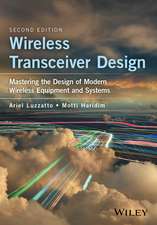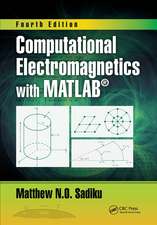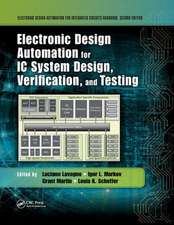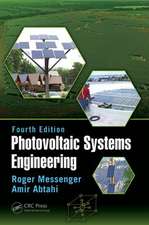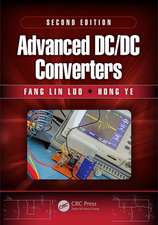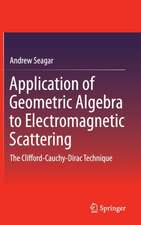Small and Short-Range Radar Systems: Modern and Practical Approaches to Electrical Engineering
Autor Gregory L. Charvaten Limba Engleză Hardback – 4 apr 2014
Author Gregory L. Charvat appeared on CNN on March 17, 2014 to discuss whether Malaysia Airlines Flight 370 might have literally flown below the radar. He appeared again on CNN on March 20, 2014 to explain the basics of radar, and he explored the hope and limitations of the technology involved in the search for Flight 370 on CBS on March 22, 2014.
Get His Book Now
Coupling theory with reality, from derivation to implementation of actual radar systems, Small and Short-Range Radar Systems analyzes and then provides design procedures and working design examples of small and short-range radar systems. Discussing applications from automotive to through-wall imaging, autonomous vehicle, and beyond, the practical text supplies high-level descriptions, theoretical derrivations, back-of-envelope calculations, explanations of processing algorithms, and case studies for each type of small radar system covered, including continuous wave (CW), ultrawideband (UWB) impulse, linear frequency modulation (FM), linear rail synthetic aperture radar (SAR), and phased array. This essential reference:
- Explains how to design your own radar devices
- Demonstrates how to process data from small radar sensors
- Provides real-world, measured radar data to test algorithms before investing development time
| Toate formatele și edițiile | Preț | Express |
|---|---|---|
| Paperback (1) | 641.35 lei 6-8 săpt. | |
| CRC Press – 23 oct 2017 | 641.35 lei 6-8 săpt. | |
| Hardback (1) | 1413.38 lei 6-8 săpt. | |
| CRC Press – 4 apr 2014 | 1413.38 lei 6-8 săpt. |
Preț: 1413.38 lei
Preț vechi: 1899.31 lei
-26% Nou
Puncte Express: 2120
Preț estimativ în valută:
270.49€ • 280.25$ • 225.74£
270.49€ • 280.25$ • 225.74£
Carte tipărită la comandă
Livrare economică 22 martie-05 aprilie
Preluare comenzi: 021 569.72.76
Specificații
ISBN-13: 9781439865996
ISBN-10: 143986599X
Pagini: 428
Ilustrații: 247 colour illustrations, 40 black & white tables
Dimensiuni: 156 x 234 x 33 mm
Greutate: 0.95 kg
Ediția:New.
Editura: CRC Press
Colecția CRC Press
Seria Modern and Practical Approaches to Electrical Engineering
ISBN-10: 143986599X
Pagini: 428
Ilustrații: 247 colour illustrations, 40 black & white tables
Dimensiuni: 156 x 234 x 33 mm
Greutate: 0.95 kg
Ediția:New.
Editura: CRC Press
Colecția CRC Press
Seria Modern and Practical Approaches to Electrical Engineering
Public țintă
Academic, Postgraduate, and Undergraduate AdvancedCuprins
RAdio Direction And Ranging (RADAR). Short-Range Radar Systems and Implementations. Continuous Wave (CW) RADAR. Frequency Modulated Continuous Wave (FMCW) Radar. Synthetic Aperture Radar. Practical Examples of Small Synthetic Aperture Radar Imaging Systems. Phased Array Radar. Ultrawideband (UWB) Impulse Radar. Applications. Police Doppler Radar and Motion Sensors. Automotive Radar. Through-Wall Radar.
Notă biografică
Gregory L. Charvat, Ph.D is co-founder of Butterfly Network Inc., visiting researcher at the Camera Culture Group MIT Media Lab, academic advisor to startups, and editor of the Gregory L. Charvat Series on Practical Approaches to Electrical Engineering. He was a technical staff member at MIT Lincoln Laboratory from September 2007 to November 2011, where his work on through-wall radar won best paper at the 2010 MSS Tri-Services Radar Symposium and is an MIT Office of the Provost 2011 research highlight. He has taught short radar courses at the Massachusetts Institute of Technology, where his Build a Small Radar Sensor course was the top-ranked MIT professional education course in 201l and has become widely adopted by other universities, laboratories, and private organizations. He has developed numerous rail SAR imaging sensors, phased array radar systems, and impulse radar systems; holds several patents; and has developed many other radar sensors and radio and audio equipment. He earned a Ph.D in electrical engineering in 2007, MSEE in 2003, and BSEE in 2002 from Michigan State University, and is a senior member of the IEEE, where he served on the steering committee for the 2010 and 2013 IEEE International Symposium on Phased Array Systems and Technology and chaired the IEEE AP-S Boston Chapter from 2010-2011.
Recenzii
"This book is absolutely unique in its focus on hands-on construction and demonstration of a variety of small, low-power, short-range radar systems. It is supported by extensive online support resources: measured data sets, MATLAB® analysis software, additional documentation, and demonstration videos. With the aid of this book, anyone with basic electronic circuit skills can construct and operate their own small radar systems and demonstrate essential radar techniques, from such basic operations as moving target detection and speed measurement to sophisticated imaging methods. …It is no exaggeration to say that no other book compares with this one. There are many books on radar systems generally and radar signal processing specifically, and also a few books or chapters in edited books that specifically address FMCW radar, but none has the emphasis on practical radar construction with detailed circuit design and experimental data seen in this text. …Short-range radars are increasingly ubiquitous, not only in the traditional police, motion sensing, and proximity applications, but increasingly in automotive safety, through-wall imaging, and others. This book is a comprehensive guide to the technology of this increasingly important area."
—Dr. Mark A. Richards, Georgia Institute of Technology, Atlanta, USA
"The book is applications-oriented with just enough information, delivered at just the right points, to give the reader a straightforward, clear understanding and appreciation of radar for practical applications. I can think of no other texts that specifically apply conventional radar theory to general short-range problems. As inexpensive imaging and short-range radars are becoming increasing prevalent, it is important that good texts be available to teach engineers about the right way to go about building radars and optimizing their performance. …The selection and presentation of topics is perfect for the modern radar engineer. Proceeding from a general description of radar theory to specific radar systems to particular applications is logical and intuitive. Nothing within the scope of the book is left out: it is very complete. …This book is a great reference, one that should be on every radar designer’s bookshelf. It is segmented enough with self-contained sections to make it easy to find solutions to specific engineering problems down the road. I particularly like the parallel structure of the various radar implementations. Giving the expected performance of each radar system, for example, guides the reader in his/her selection of a particular configuration for a given application. …The references are numerous and complete, and the author is well-known as an active contributor in the radar field. In addition, the text provides sufficient theory to justify each next step. …Unlike conventional radar texts, Charvat’s book gives the reader the knowledge and understanding to develop and use radars for practical, everyday applications. The presentation reminds me of a car-repair manual, with careful step-by-step instructions and well-illustrated with highlighted photographs and circuit diagrams, but with just enough math to justify the various approaches used."
—Prof. Carey Rappaport, Northeastern University, Boston, Massachusetts, USA
"This textbook fills a large void by providing real world examples of Doppler, ranging, and synthetic aperture radar systems along with extensive examples of radar sensitivity and design parameters. Its coverage of fundamental radar principles in a form directly accessible to students is unique, and provides a needed hands-on based approach to the subject. It enables radar investigations using systems that can be readily built at reasonable cost, straightforward computer analysis code, and well verified test data. Students can use these features to learn radar by example in a manner previously very difficult to accomplish. …The material fills a niche not currently found in the literature: real-world examples of small radar systems that can be implemented by students and professionals new to the field. There is a large need for such material in the university and educational community, as most radar courses feature large and complex system designs costing significant amounts of money. This fact tends to produce a large disconnect in student minds between the theory they are learning and actual practice in how to implement this theory. In other words, the student assumes that it must take a team of people and a lot of resources to successfully implement and deploy radar systems. However, the principles of radar work equally well on small systems. The ability to have students assemble, test, and process data from these systems is really invaluable. I have seen this type of hands-on learning provide insights and synthesis of material much quicker than traditional methods of learning important radar principles. Having a textbook with validated examples of small radar systems, and with simple computer code and test data sets to check knowledge of theoretical constructs, provides the needed bridge to this type of learning. …The material is most definitely interesting, primarily by virtue of worked-out calculations giving real-world answers to common radar design problems (and then showing processed data examples). There are practically no sources of publicly available test data for SAR algorithms or for FMCW ranging radars. These worked-out examples are therefore unique and badly needed. …I am impressed with the breadth of topics covered. For the target audience, this material seems ideally suited and I do not find any significant missing topics. After assimilating this material and working through the exercises, students will be much more ready to tackle the classic radar textbooks (Skolnik, etc.) and will have a much more intuitive feel for core principles."
—Dr. Philip Erickson, Principal Research Scientist, MIT Haystack Observatory, Westford, Massachusetts, USA
"I wish I had a book like this when I was developing short-range radars. The author provides a variety of practical circuits and block diagrams that practicing engineers and students will find useful. …The best feature of this book is the wealth of practical information in the form of block diagrams, circuit diagrams, and measurement results that help the reader understand how to turn the theory of small radars into practice. I like the author’s approach of providing just enough theory to help the reader understand the operation of short-range radars and to interpret the measurement results. …I’m not aware of any other book directed solely toward small and short-range radars. I believe this book is complementary to comprehensive treatments such as Principles of Modern Radar by Richards, Scheer, and Holm and Skolnik’s Radar Handbook."
––Prof. Daniel Fleisch, Ph.D, Wittenberg University, Springfield, Ohio, USA
"This book presents a nice introduction to short-range radar systems with both theoretical and practical insights. I would recommend it to anyone interested in not only understanding but also building short-range radar systems. …The book covers all essential aspects of short-range low-power radar systems. A major strength of the book lies in the combination of both theoretical and practical insights. The examples provided in the book are particularly helpful in not only understanding but also in building actual systems."
—Prof. Xiaoguang ‘Leo’ Liu, Ph.D, University of California, Davis, USA
"This book is one of the first to discuss short-range radar (SRR) systems in detail, from both theoretical and practical standpoints. ... The book is a good source of information about radar technology and the latest state of the art in small and shortrange radars."
—Satyajayant Misra, from IEEE Wireless Communications - June 2015
"Finally, bedtime reading for the radar enthusiast! Readers should not succumb to the unintended implication that this book will put them to sleep. On the contrary, this is an eye-opener. It is an interesting book that is quite easy to dip into. This book is a great reference for a hands-on approach toward understanding, construction, and use of a variety of home-made, short-range radar systems."
—IEEE Antennas & Propagation Magazine, August 2016
"This book is absolutely unique in its focus on hands-on construction and demonstration of a variety of small, low-power, short-range radar systems. It is supported by extensive online support resources: measured data sets, MATLAB® analysis software, additional documentation, and demonstration videos. With the aid of this book, anyone with basic electronic circuit skills can construct and operate their own small radar systems and demonstrate essential radar techniques, from such basic operations as moving target detection and speed measurement to sophisticated imaging methods. …It is no exaggeration to say that no other book compares with this one. There are many books on radar systems generally and radar signal processing specifically, and also a few books or chapters in edited books that specifically address FMCW radar, but none has the emphasis on practical radar construction with detailed circuit design and experimental data seen in this text. …Short-range radars are increasingly ubiquitous, not only in the traditional police, motion sensing, and proximity applications, but increasingly in automotive safety, through-wall imaging, and others. This book is a comprehensive guide to the technology of this increasingly important area."
—Dr. Mark A. Richards, Georgia Institute of Technology, Atlanta, USA
"The book is applications-oriented with just enough information, delivered at just the right points, to give the reader a straightforward, clear understanding and appreciation of radar for practical applications. I can think of no other texts that specifically apply conventional radar theory to general short-range problems. As inexpensive imaging and short-range radars are becoming increasing prevalent, it is important that good texts be available to teach engineers about the right way to go about building radars and optimizing their performance. …The selection and presentation of topics is perfect for the modern radar engineer. Proceeding from a general description of radar theory to specific radar systems to particular applications is logical and intuitive. Nothing within the scope of the book is left out: it is very complete. …This book is a great reference, one that should be on every radar designer’s bookshelf. It is segmented enough with self-contained sections to make it easy to find solutions to specific engineering problems down the road. I particularly like the parallel structure of the various radar implementations. Giving the expected performance of each radar system, for example, guides the reader in his/her selection of a particular configuration for a given application. …The references are numerous and complete, and the author is well-known as an active contributor in the radar field. In addition, the text provides sufficient theory to justify each next step. …Unlike conventional radar texts, Charvat’s book gives the reader the knowledge and understanding to develop and use radars for practical, everyday applications. The presentation reminds me of a car-repair manual, with careful step-by-step instructions and well-illustrated with highlighted photographs and circuit diagrams, but with just enough math to justify the various approaches used."
—Prof. Carey Rappaport, Northeastern University, Boston, Massachusetts, USA
"This textbook fills a large void by providing real world examples of Doppler, ranging, and synthetic aperture radar systems along with extensive examples of radar sensitivity and design parameters. Its coverage of fundamental radar principles in a form directly accessible to students is unique, and provides a needed hands-on based approach to the subject. It enables radar investigations using systems that can be readily built at reasonable cost, straightforward computer analysis code, and well verified test data. Students can use these features to learn radar by example in a manner previously very difficult to accomplish. …The material fills a niche not currently found in the literature: real-world examples of small radar systems that can be implemented by students and professionals new to the field. There is a large need for such material in the university and educational community, as most radar courses feature large and complex system designs costing significant amounts of money. This fact tends to produce a large disconnect in student minds between the theory they are learning and actual practice in how to implement this theory. In other words, the student assumes that it must take a team of people and a lot of resources to successfully implement and deploy radar systems. However, the principles of radar work equally well on small systems. The ability to have students assemble, test, and process data from these systems is really invaluable. I have seen this type of hands-on learning provide insights and synthesis of material much quicker than traditional methods of learning important radar principles. Having a textbook with validated examples of small radar systems, and with simple computer code and test data sets to check knowledge of theoretical constructs, provides the needed bridge to this type of learning. …The material is most definitely interesting, primarily by virtue of worked-out calculations giving real-world answers to common radar design problems (and then showing processed data examples). There are practically no sources of publicly available test data for SAR algorithms or for FMCW ranging radars. These worked-out examples are therefore unique and badly needed. …I am impressed with the breadth of topics covered. For the target audience, this material seems ideally suited and I do not find any significant missing topics. After assimilating this material and working through the exercises, students will be much more ready to tackle the classic radar textbooks (Skolnik, etc.) and will have a much more intuitive feel for core principles."
—Dr. Philip Erickson, Principal Research Scientist, MIT Haystack Observatory, Westford, Massachusetts, USA
"I wish I had a book like this when I was developing short-range radars. The author provides a variety of practical circuits and block diagrams that practicing engineers and students will find useful. …The best feature of this book is the wealth of practical information in the form of block diagrams, circuit diagrams, and measurement results that help the reader understand how to turn the theory of small radars into practice. I like the author’s approach of providing just enough theory to help the reader understand the operation of short-range radars and to interpret the measurement results. …I’m not aware of any other book directed solely toward small and short-range radars. I believe this book is complementary to comprehensive treatments such as Principles of Modern Radar by Richards, Scheer, and Holm and Skolnik’s Radar Handbook."
––Prof. Daniel Fleisch, Ph.D, Wittenberg University, Springfield, Ohio, USA
"This book presents a nice introduction to short-range radar systems with both theoretical and practical insights. I would recommend it to anyone interested in not only understanding but also building short-range radar systems. …The book covers all essential aspects of short-range low-power radar systems. A major strength of the book lies in the combination of both theoretical and practical insights. The examples provided in the book are particularly helpful in not only understanding but also in building actual systems."
—Prof. Xiaoguang ‘Leo’ Liu, Ph.D, University of California, Davis, USA
"This book is one of the first to discuss short-range radar (SRR) systems in detail, from both theoretical and practical standpoints. ... The book is a good source of information about radar technology and the latest state of the art in small and shortrange radars."
—Satyajayant Misra, from IEEE Wireless Communications - June 2015
"Finally, bedtime reading for the radar enthusiast! Readers should not succumb to the unintended implication that this book will put them to sleep. On the contrary, this is an eye-opener. It is an interesting book that is quite easy to dip into. This book is a great reference for a hands-on approach toward understanding, construction, and use of a variety of home-made, short-range radar systems."
—IEEE Antennas & Propagation Magazine, August 2016
"Although the majority of radar systems – for applications such as air traffic control, maritime navigation and military surveillance – are designed to detect and track targets at long range, there is an important class of radars that work at much shorter ranges. These are becoming more and more attractive for applications that include radar imaging from drone platforms, automotive radar (for collision avoidance and autonomous operation) and through-wall radar. This book therefore fills an important niche. Its author is well-qualified to write such a book, with a wide experience both in academic and industry research and development, as well as in amateur radio.
The author’s background gives the book a strong practical approach, though not at the expense of rigour. It includes plenty of practical designs and examples of results, encouraging the reader to build and test the designs. It is organised in ten chapters: Chapter 1 covers the basics of radar; Chapters 2 and 3 describe Continuous Wave (CW) and Frequency-Modulated Continuous Wave (FMCW) radars; Chapter 4 covers Synthetic Aperture Radar (SAR) imaging; Chapters 5, 6 and 7 treat, respectively, small SAR systems, phased array radar and ultrawideband (UWB) impulse radar; Chapters 8, 9 and 10 cover different applications of short-range radars – police Doppler and motion sensors, automotive radar and through-wall radars. Authors from General Motors contributed to Chapter 9, thus ensuring that it is up-to-date and relevant.
A supporting website provides MATLAB® simulation scripts and video demonstrations and every encouragement to contact the author to provide feedback and to ask questions.
In summary, this is a rather unusual and attractive book that can be confidently recommended. It may be of particular value in the design of laboratory exercises for undergraduate and masters-level students, but also to those in academia and industry who research and develop radars in these new and increasingly important domains."
— H.D. Griffiths, from The Aeronautical Journal, August 2019
—Dr. Mark A. Richards, Georgia Institute of Technology, Atlanta, USA
"The book is applications-oriented with just enough information, delivered at just the right points, to give the reader a straightforward, clear understanding and appreciation of radar for practical applications. I can think of no other texts that specifically apply conventional radar theory to general short-range problems. As inexpensive imaging and short-range radars are becoming increasing prevalent, it is important that good texts be available to teach engineers about the right way to go about building radars and optimizing their performance. …The selection and presentation of topics is perfect for the modern radar engineer. Proceeding from a general description of radar theory to specific radar systems to particular applications is logical and intuitive. Nothing within the scope of the book is left out: it is very complete. …This book is a great reference, one that should be on every radar designer’s bookshelf. It is segmented enough with self-contained sections to make it easy to find solutions to specific engineering problems down the road. I particularly like the parallel structure of the various radar implementations. Giving the expected performance of each radar system, for example, guides the reader in his/her selection of a particular configuration for a given application. …The references are numerous and complete, and the author is well-known as an active contributor in the radar field. In addition, the text provides sufficient theory to justify each next step. …Unlike conventional radar texts, Charvat’s book gives the reader the knowledge and understanding to develop and use radars for practical, everyday applications. The presentation reminds me of a car-repair manual, with careful step-by-step instructions and well-illustrated with highlighted photographs and circuit diagrams, but with just enough math to justify the various approaches used."
—Prof. Carey Rappaport, Northeastern University, Boston, Massachusetts, USA
"This textbook fills a large void by providing real world examples of Doppler, ranging, and synthetic aperture radar systems along with extensive examples of radar sensitivity and design parameters. Its coverage of fundamental radar principles in a form directly accessible to students is unique, and provides a needed hands-on based approach to the subject. It enables radar investigations using systems that can be readily built at reasonable cost, straightforward computer analysis code, and well verified test data. Students can use these features to learn radar by example in a manner previously very difficult to accomplish. …The material fills a niche not currently found in the literature: real-world examples of small radar systems that can be implemented by students and professionals new to the field. There is a large need for such material in the university and educational community, as most radar courses feature large and complex system designs costing significant amounts of money. This fact tends to produce a large disconnect in student minds between the theory they are learning and actual practice in how to implement this theory. In other words, the student assumes that it must take a team of people and a lot of resources to successfully implement and deploy radar systems. However, the principles of radar work equally well on small systems. The ability to have students assemble, test, and process data from these systems is really invaluable. I have seen this type of hands-on learning provide insights and synthesis of material much quicker than traditional methods of learning important radar principles. Having a textbook with validated examples of small radar systems, and with simple computer code and test data sets to check knowledge of theoretical constructs, provides the needed bridge to this type of learning. …The material is most definitely interesting, primarily by virtue of worked-out calculations giving real-world answers to common radar design problems (and then showing processed data examples). There are practically no sources of publicly available test data for SAR algorithms or for FMCW ranging radars. These worked-out examples are therefore unique and badly needed. …I am impressed with the breadth of topics covered. For the target audience, this material seems ideally suited and I do not find any significant missing topics. After assimilating this material and working through the exercises, students will be much more ready to tackle the classic radar textbooks (Skolnik, etc.) and will have a much more intuitive feel for core principles."
—Dr. Philip Erickson, Principal Research Scientist, MIT Haystack Observatory, Westford, Massachusetts, USA
"I wish I had a book like this when I was developing short-range radars. The author provides a variety of practical circuits and block diagrams that practicing engineers and students will find useful. …The best feature of this book is the wealth of practical information in the form of block diagrams, circuit diagrams, and measurement results that help the reader understand how to turn the theory of small radars into practice. I like the author’s approach of providing just enough theory to help the reader understand the operation of short-range radars and to interpret the measurement results. …I’m not aware of any other book directed solely toward small and short-range radars. I believe this book is complementary to comprehensive treatments such as Principles of Modern Radar by Richards, Scheer, and Holm and Skolnik’s Radar Handbook."
––Prof. Daniel Fleisch, Ph.D, Wittenberg University, Springfield, Ohio, USA
"This book presents a nice introduction to short-range radar systems with both theoretical and practical insights. I would recommend it to anyone interested in not only understanding but also building short-range radar systems. …The book covers all essential aspects of short-range low-power radar systems. A major strength of the book lies in the combination of both theoretical and practical insights. The examples provided in the book are particularly helpful in not only understanding but also in building actual systems."
—Prof. Xiaoguang ‘Leo’ Liu, Ph.D, University of California, Davis, USA
"This book is one of the first to discuss short-range radar (SRR) systems in detail, from both theoretical and practical standpoints. ... The book is a good source of information about radar technology and the latest state of the art in small and shortrange radars."
—Satyajayant Misra, from IEEE Wireless Communications - June 2015
"Finally, bedtime reading for the radar enthusiast! Readers should not succumb to the unintended implication that this book will put them to sleep. On the contrary, this is an eye-opener. It is an interesting book that is quite easy to dip into. This book is a great reference for a hands-on approach toward understanding, construction, and use of a variety of home-made, short-range radar systems."
—IEEE Antennas & Propagation Magazine, August 2016
"This book is absolutely unique in its focus on hands-on construction and demonstration of a variety of small, low-power, short-range radar systems. It is supported by extensive online support resources: measured data sets, MATLAB® analysis software, additional documentation, and demonstration videos. With the aid of this book, anyone with basic electronic circuit skills can construct and operate their own small radar systems and demonstrate essential radar techniques, from such basic operations as moving target detection and speed measurement to sophisticated imaging methods. …It is no exaggeration to say that no other book compares with this one. There are many books on radar systems generally and radar signal processing specifically, and also a few books or chapters in edited books that specifically address FMCW radar, but none has the emphasis on practical radar construction with detailed circuit design and experimental data seen in this text. …Short-range radars are increasingly ubiquitous, not only in the traditional police, motion sensing, and proximity applications, but increasingly in automotive safety, through-wall imaging, and others. This book is a comprehensive guide to the technology of this increasingly important area."
—Dr. Mark A. Richards, Georgia Institute of Technology, Atlanta, USA
"The book is applications-oriented with just enough information, delivered at just the right points, to give the reader a straightforward, clear understanding and appreciation of radar for practical applications. I can think of no other texts that specifically apply conventional radar theory to general short-range problems. As inexpensive imaging and short-range radars are becoming increasing prevalent, it is important that good texts be available to teach engineers about the right way to go about building radars and optimizing their performance. …The selection and presentation of topics is perfect for the modern radar engineer. Proceeding from a general description of radar theory to specific radar systems to particular applications is logical and intuitive. Nothing within the scope of the book is left out: it is very complete. …This book is a great reference, one that should be on every radar designer’s bookshelf. It is segmented enough with self-contained sections to make it easy to find solutions to specific engineering problems down the road. I particularly like the parallel structure of the various radar implementations. Giving the expected performance of each radar system, for example, guides the reader in his/her selection of a particular configuration for a given application. …The references are numerous and complete, and the author is well-known as an active contributor in the radar field. In addition, the text provides sufficient theory to justify each next step. …Unlike conventional radar texts, Charvat’s book gives the reader the knowledge and understanding to develop and use radars for practical, everyday applications. The presentation reminds me of a car-repair manual, with careful step-by-step instructions and well-illustrated with highlighted photographs and circuit diagrams, but with just enough math to justify the various approaches used."
—Prof. Carey Rappaport, Northeastern University, Boston, Massachusetts, USA
"This textbook fills a large void by providing real world examples of Doppler, ranging, and synthetic aperture radar systems along with extensive examples of radar sensitivity and design parameters. Its coverage of fundamental radar principles in a form directly accessible to students is unique, and provides a needed hands-on based approach to the subject. It enables radar investigations using systems that can be readily built at reasonable cost, straightforward computer analysis code, and well verified test data. Students can use these features to learn radar by example in a manner previously very difficult to accomplish. …The material fills a niche not currently found in the literature: real-world examples of small radar systems that can be implemented by students and professionals new to the field. There is a large need for such material in the university and educational community, as most radar courses feature large and complex system designs costing significant amounts of money. This fact tends to produce a large disconnect in student minds between the theory they are learning and actual practice in how to implement this theory. In other words, the student assumes that it must take a team of people and a lot of resources to successfully implement and deploy radar systems. However, the principles of radar work equally well on small systems. The ability to have students assemble, test, and process data from these systems is really invaluable. I have seen this type of hands-on learning provide insights and synthesis of material much quicker than traditional methods of learning important radar principles. Having a textbook with validated examples of small radar systems, and with simple computer code and test data sets to check knowledge of theoretical constructs, provides the needed bridge to this type of learning. …The material is most definitely interesting, primarily by virtue of worked-out calculations giving real-world answers to common radar design problems (and then showing processed data examples). There are practically no sources of publicly available test data for SAR algorithms or for FMCW ranging radars. These worked-out examples are therefore unique and badly needed. …I am impressed with the breadth of topics covered. For the target audience, this material seems ideally suited and I do not find any significant missing topics. After assimilating this material and working through the exercises, students will be much more ready to tackle the classic radar textbooks (Skolnik, etc.) and will have a much more intuitive feel for core principles."
—Dr. Philip Erickson, Principal Research Scientist, MIT Haystack Observatory, Westford, Massachusetts, USA
"I wish I had a book like this when I was developing short-range radars. The author provides a variety of practical circuits and block diagrams that practicing engineers and students will find useful. …The best feature of this book is the wealth of practical information in the form of block diagrams, circuit diagrams, and measurement results that help the reader understand how to turn the theory of small radars into practice. I like the author’s approach of providing just enough theory to help the reader understand the operation of short-range radars and to interpret the measurement results. …I’m not aware of any other book directed solely toward small and short-range radars. I believe this book is complementary to comprehensive treatments such as Principles of Modern Radar by Richards, Scheer, and Holm and Skolnik’s Radar Handbook."
––Prof. Daniel Fleisch, Ph.D, Wittenberg University, Springfield, Ohio, USA
"This book presents a nice introduction to short-range radar systems with both theoretical and practical insights. I would recommend it to anyone interested in not only understanding but also building short-range radar systems. …The book covers all essential aspects of short-range low-power radar systems. A major strength of the book lies in the combination of both theoretical and practical insights. The examples provided in the book are particularly helpful in not only understanding but also in building actual systems."
—Prof. Xiaoguang ‘Leo’ Liu, Ph.D, University of California, Davis, USA
"This book is one of the first to discuss short-range radar (SRR) systems in detail, from both theoretical and practical standpoints. ... The book is a good source of information about radar technology and the latest state of the art in small and shortrange radars."
—Satyajayant Misra, from IEEE Wireless Communications - June 2015
"Finally, bedtime reading for the radar enthusiast! Readers should not succumb to the unintended implication that this book will put them to sleep. On the contrary, this is an eye-opener. It is an interesting book that is quite easy to dip into. This book is a great reference for a hands-on approach toward understanding, construction, and use of a variety of home-made, short-range radar systems."
—IEEE Antennas & Propagation Magazine, August 2016
"Although the majority of radar systems – for applications such as air traffic control, maritime navigation and military surveillance – are designed to detect and track targets at long range, there is an important class of radars that work at much shorter ranges. These are becoming more and more attractive for applications that include radar imaging from drone platforms, automotive radar (for collision avoidance and autonomous operation) and through-wall radar. This book therefore fills an important niche. Its author is well-qualified to write such a book, with a wide experience both in academic and industry research and development, as well as in amateur radio.
The author’s background gives the book a strong practical approach, though not at the expense of rigour. It includes plenty of practical designs and examples of results, encouraging the reader to build and test the designs. It is organised in ten chapters: Chapter 1 covers the basics of radar; Chapters 2 and 3 describe Continuous Wave (CW) and Frequency-Modulated Continuous Wave (FMCW) radars; Chapter 4 covers Synthetic Aperture Radar (SAR) imaging; Chapters 5, 6 and 7 treat, respectively, small SAR systems, phased array radar and ultrawideband (UWB) impulse radar; Chapters 8, 9 and 10 cover different applications of short-range radars – police Doppler and motion sensors, automotive radar and through-wall radars. Authors from General Motors contributed to Chapter 9, thus ensuring that it is up-to-date and relevant.
A supporting website provides MATLAB® simulation scripts and video demonstrations and every encouragement to contact the author to provide feedback and to ask questions.
In summary, this is a rather unusual and attractive book that can be confidently recommended. It may be of particular value in the design of laboratory exercises for undergraduate and masters-level students, but also to those in academia and industry who research and develop radars in these new and increasingly important domains."
— H.D. Griffiths, from The Aeronautical Journal, August 2019
Descriere
Coupling theory with reality, from derivation to implementation of actual radar systems, this essential reference analyzes and then provides design procedures and working design examples of small and short-range radar systems. Discussing applications from automotive to through-wall imaging, the practical text supplies high-level descriptions, theoretical derrivations, back-of-envelope calculations, explanations of processing algorithms, and case studies for each type of small radar system covered, including continuous wave, ultrawideband impulse, phased array, and more, effectively demonstrating how to quickly move a design from concept to reality.



